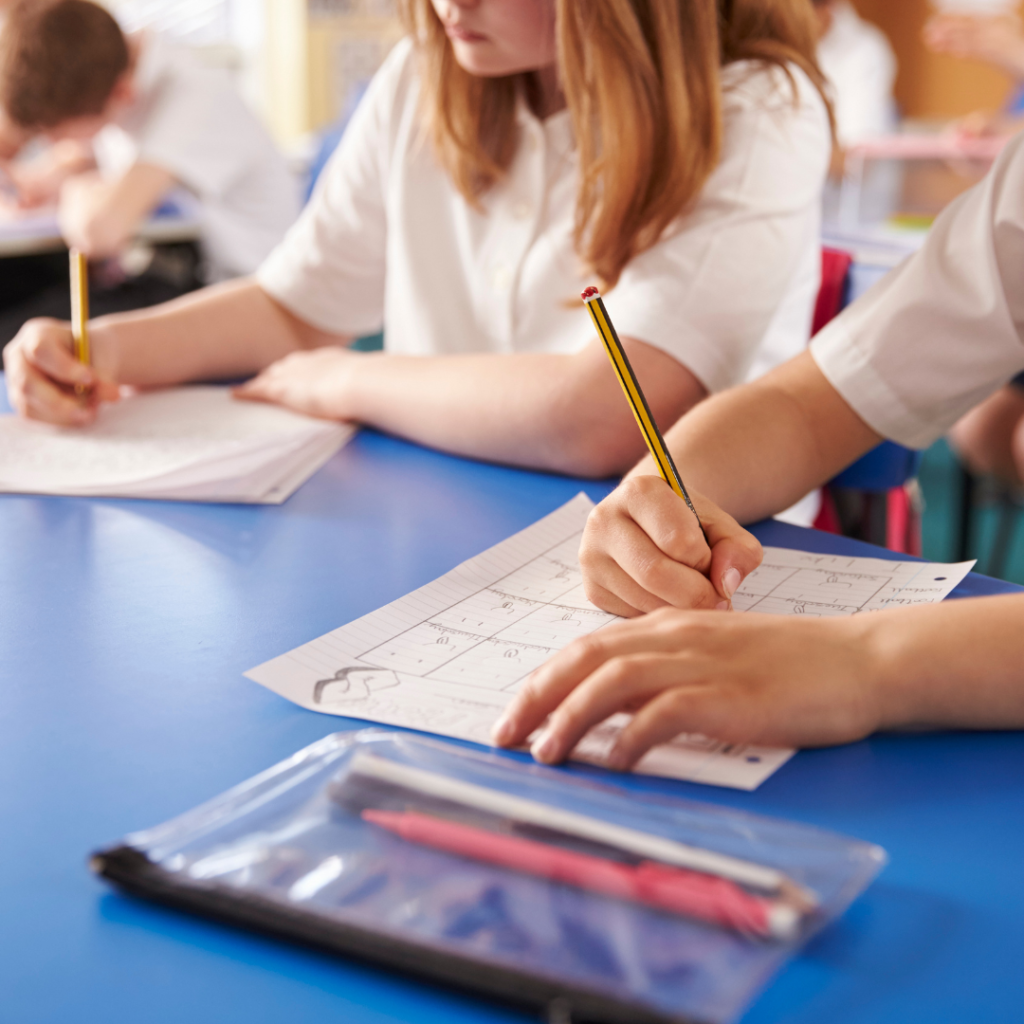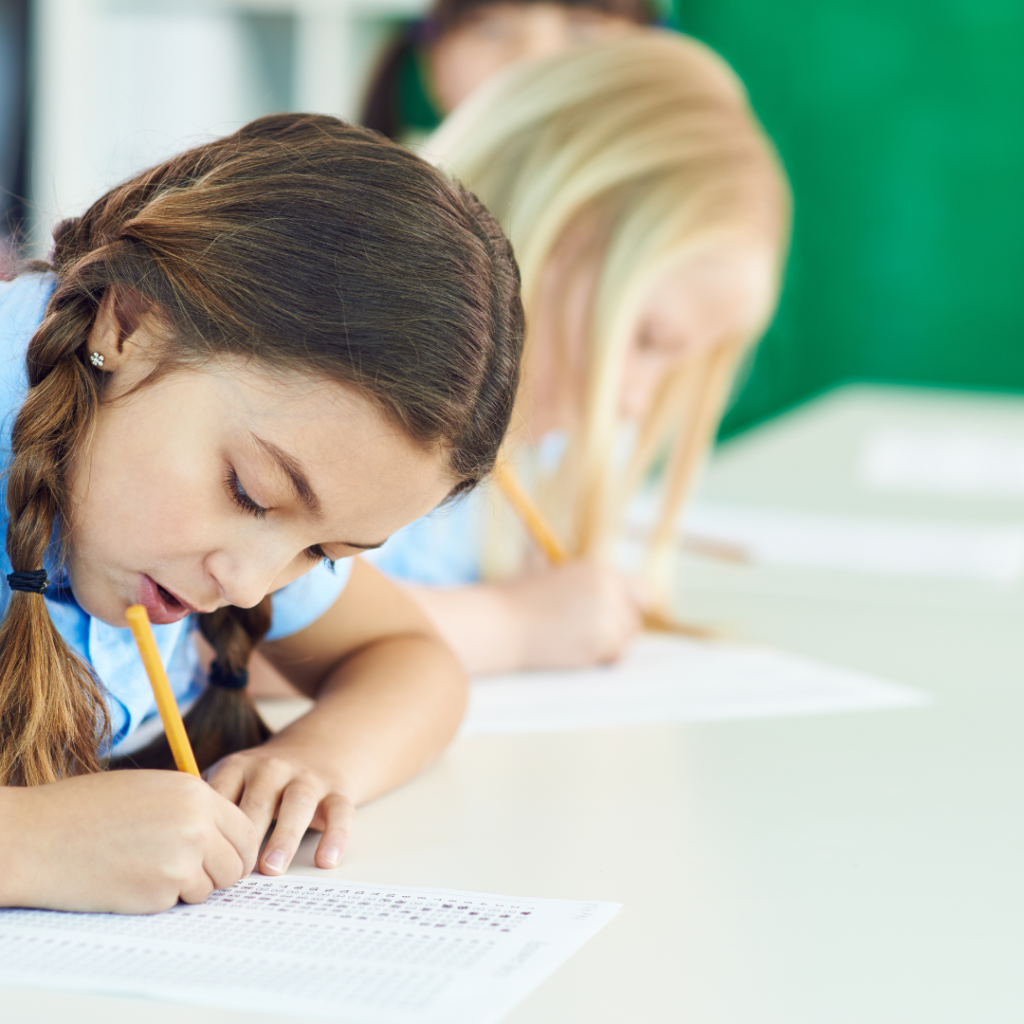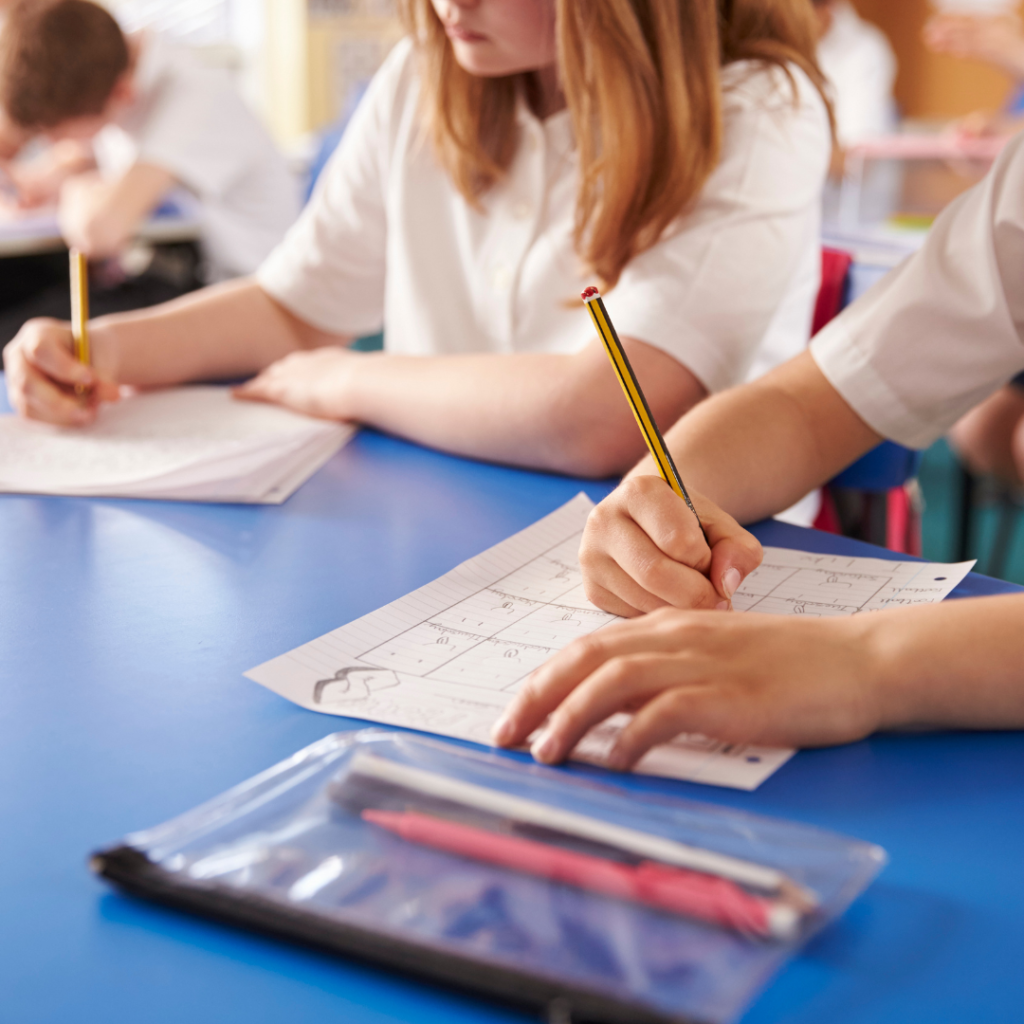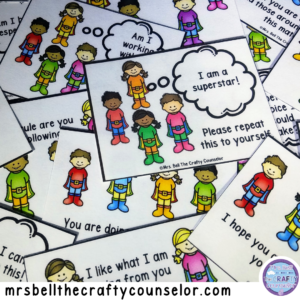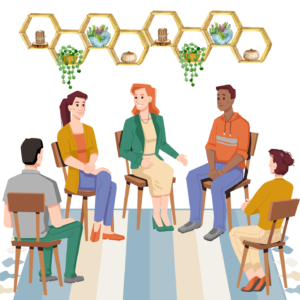
10 Desk-Based Test Anxiety Tips for Students to Reduce Stress During Testing
I’m always searching for new test anxiety tips for students. Standardized testing can be a source of stress and anxiety for many students. The pressure to perform well can be overwhelming. To make things worse, most of the time, children have to sit quietly and calmly for extended timeframes.
Anxiety mixed with sitting still never works out well for me.
During standardized testing, students are often required to remain at their desks for long periods without much movement. This can be challenging for students who struggle with anxiety, stress, or self-control.
However, there are many strategies that students can use to reduce test anxiety and stress without moving around the room. When the dreaded testing season is quickly closing in on my students, I start teaching strategies they can use to reduce test anxiety and stress while still remaining seated at their desks.
Let me tell you; it’s been a game-changer for my children.
Here are ten tips for students to reduce test anxiety and stress during standardized testing:
Ten Test Anxiety Tips for Students
Deep Breathing Strategies
Deep breathing exercises can help calm the body and relax the mind. They are the easiest test anxiety tips for students to implement because you can do all exercises while seated. Encourage your kids to take a few deep breaths before starting the test. This will help them to start off feeling more relaxed and focused, with a clearer and calmer mind.
There are many breathing strategies that students can utilize from their desks to help reduce any feelings or anxiety or nervousness that may bubble up while testing.
Here are three of my favorite deep breathing-based test anxiety tips for students:
- Square Breathing – Place your finger on your desk for the starting point of your square. Inhale for a count of four, and you draw an imaginary line with your finger, creating the first side of your square. Hold for a count of four as you draw your line. Exhale for a count of four as you move your finger to the left, creating the bottom of your square. Hold the exhale for a count of four as you draw. Inhale as you move your finger up, creating the third side of the square. Exhale as you draw the top and final sides of the square. Repeat this pattern as needed, aiming to make each breath slow and even.
- Ocean Breathing: Imagine the sound of waves crashing on the shore. Inhale deeply through your nose for a count of three, hold for a count of three, and then exhale through your mouth for a count of three, making a “haaa” sound in your mind. Repeat this pattern for several breaths.
- Counting Breath: Inhale deeply through your nose and count to four, then exhale through your mouth and count to six. Then inhale deeply for a count of five, and exhale for a count of seven. Repeat this pattern for several breaths, aiming to make each exhale longer than the inhale.
Stretch
While students may not be able to move around the room freely during standardized testing, they can still quietly stretch while seated at their desks.
Stretching can help release tension and increase blood flow. Encourage students to stretch their arms, legs, and neck. These test anxiety tips for students will help them feel more alert and focused.
Teach children seated stretching exercises such as these:
| Body Part | Exercise |
|---|---|
| Neck | Gently tilt your head to one side, bringing your ear toward your shoulder until you feel a stretch. Hold for 15-30 seconds, and then repeat on the other side. |
| Shoulders | Roll your shoulders forward and backward, and then raise both shoulders up toward your ears and hold for a few seconds before relaxing. Repeat 5-10 times. |
| Back | Sit up tall in your chair and place your hands behind your head. Gently arch your back and look up toward the ceiling, feeling a stretch in your upper back. Hold for 10-15 seconds, and then release. |
| Hips | Sit up tall in your chair and bring one knee up toward your chest, holding onto your shin with both hands. Gently rock your knee back and forth to stretch your hip flexors. Repeat on the other side. |
| Hamstrings | Sit up tall in your chair and extend one leg out in front of you, keeping your heel on the floor. Gently lean forward from your hips until you feel a stretch in the back of your thigh. Hold for 15-30 seconds, and then repeat on the other leg. |
| Calves | Sit up tall in your chair and extend one leg out in front of you, keeping your heel on the floor. Flex your foot and gently pull your toes back toward your shin until you feel a stretch in your calf. Hold for 15-30 seconds, and then repeat on the other leg. |
Remind students to breathe deeply and slowly while they are stretching and to stop if they feel any pain or discomfort. These test anxiety tips for students & exercises are designed to be done quietly and discreetly at your desk, but they may not work for everyone to reduce nervous energy or stress.
Encourage students to see which test-taking tips are the best fit for them. Not all test anxiety tips will work for all students.
Visualize Success
Our minds are so incredibly powerful. Visualizing success can have profound effects on children’s mindsets, self-confidence, and ability to follow through and complete tasks.
The process of visualization typically involves closing your eyes, focusing your attention, and using your imagination to create a mental image or scenario. This technique is often used in sports, music, and other performance-based activities to help individuals prepare for or improve their performance by mentally practicing and rehearsing their actions and outcomes. It’s a great test anxiety tips for students.
Encourage students to visualize themselves doing well on the test. Research has shown that visualization can have a positive impact on various aspects of mental and physical health, such as reducing stress, anxiety, and pain, improving mood, and enhancing athletic performance. Utilizing visualization techniques can help boost confidence and reduce anxiety.
Visualization is a powerful tool that can help students stay positive and focused during the test.
Focus on Positive Self-Talk
Along with visualization, positive self-talk can have profound implications when used as a test anxiety tips for students. Encourage students to focus on positive self-talk, such as “I can do this” or “I am prepared for this test.” Positive self-talk is a great way to stay motivated and focused during the test.
Positive self-talk involves intentionally speaking to yourself in a positive and encouraging way. It is a process of using constructive thinking to boost your confidence, motivation, and overall well-being. The goal of positive self-talk is to create a more positive and optimistic mindset, which can help you feel more empowered and resilient in the face of challenges and setbacks.
Positive self-talk can be particularly helpful in situations where you might be feeling anxious, stressed, or overwhelmed. By intentionally directing your thoughts toward positive and constructive thinking, you can help reduce feelings of anxiety and negativity and instead cultivate a sense of calm, confidence, and control.
Some examples of positive self-talk statements that children might be helpful when taking a test:
- I am prepared, and I know this material well.
- I have studied hard, and I am ready to do my best.
- I am calm and focused, and I can handle any challenges that come up.
- I am confident in my abilities, and I believe in myself.
- I am smart and capable, and I can figure out the answers to these questions.
- I am not defined by this test, and I will not let the outcome determine my worth.
- I am doing my best, and that is all that matters.
- I am in control of my thoughts and emotions, and I choose to feel calm and confident.
- I have succeeded in the past, and I can succeed again today.
- I trust in myself and my abilities, and I am ready to show what I know.
The goal of positive self-talk is to focus on your strengths, capabilities, and potential, and to counteract any negative or self-defeating thoughts that may arise during a test or other challenging situation.
By using these kinds of positive affirmations, students can help themselves to stay motivated, confident, and focused.
Use Positive Affirmations
Positive affirmations and positive self-talk are related but not exactly the same. Positive affirmations are often used to cultivate a specific mindset or achieve a particular goal, whereas positive self-talk is a more general practice of intentionally directing your thoughts and inner dialogue in a positive and constructive way.
Examples of positive affirmations children can use on test day are:
- I am smart, and I can do this.
- I am prepared, and I know what to do.
- I am brave, and I can face this challenge.
- I am calm and focused, and I can think clearly.
- I am proud of my hard work and effort.
- I am confident in my abilities, and I believe in myself.
- I am not alone, and my teacher and family are here to support me.
- I am doing my best, and that is all that matters.
- I can learn from my mistakes and keep improving.
- I am excited to show what I know and what I can do.
Encourage children to say these statements to themselves before and during a test or whenever they feel worried or stressed. With practice, positive affirmations can help children develop a sense of self-efficacy and resilience, which can serve them well throughout their academic and personal lives.
Take a Break
If a student is feeling overwhelmed or anxious, encourage them to take a short break to refocus and calm down. While they may not be able to leave their desk, taking a few moments to close their eyes and take deep breaths can help them reset and refocus their energy on the test.
Utilize these test anxiety tips for students when they need to step away from the reality of the situation for a minute.
Don’t underestimate the power of putting your hand down and blocking out the world for a few minutes. It could be just the reset your students need in order to become focused and ready to dominate their test.
Drink Water
Encourage students to drink water during the test to stay hydrated and focused. Dehydration can cause fatigue and lack of focus, which can increase anxiety and stress.
This may seem like a simple test anxiety tips for students, but hydrating gives students’ brains a mini break to regroup.
Use Relaxation Techniques
Encourage students to use relaxation techniques such as progressive muscle relaxation or visualization. These techniques can help students relax and stay focused during the test.
| Step | Action |
|---|---|
| 1 | Sit up straight in a comfortable position |
| 2 | Take a few slow, deep breaths, in through your nose and out through your mouth |
| 3 | Focus your attention on your feet, and slowly tense the muscles in your feet by curling your toes downward |
| 4 | Hold the tension for a few seconds, then release the tension and let your feet relax completely |
| 5 | Repeat the same process with your calf muscles, thighs, stomach, chest, back, shoulders, arms, hands, and neck |
| 6 | As you tense each muscle group, try to feel the tension building up, but don’t strain or hurt yourself |
| 7 | As you release each muscle group, focus on the feeling of relaxation spreading throughout your body |
| 8 | Take a few deep breaths and enjoy the feeling of deep relaxation in your body |
| 9 | When you’re ready, slowly open your eyes and return to your normal activities |
Progressive muscle relaxation can be a helpful test anxiety tips for students for reducing stress and promoting focus, but it’s important to listen to your body and not push yourself too hard. If your students experience any pain or discomfort while tensing their muscles, encourage them to stop and try a different strategy.
Remember a Calming Song
Some people find themselves more focused and calm when listening to certain types of music or specific songs.
Encourage students to listen to calming music before the test to reduce anxiety. Remembering the lyrics and melody as they sing the calming music in their heads can help students relax and stay focused during the test.
Test anxiety tips for students aren’t a one size fits all scenario. If a student can’t, or doesn’t like to, sing in their head, this test anxiety tips for students isn’t going to work.
Quick Doodles
Doodling can be a helpful strategy for managing test anxiety because it can help to calm the mind and reduce stress. When we doodle, we engage in a simple, repetitive activity that doesn’t require a lot of cognitive effort. This can be a helpful way to distract the mind from anxious thoughts and redirect it toward something more calming.
Doodling can have a positive impact on memory, concentration, and overall cognitive performance. When we doodle, we activate different areas of the brain that can enhance our ability to process and retain information. Doodling can be a great test anxiety tips for students.
Doodling for a few minutes when feelings of anxiety arise can help children manage those feelings and regulate their emotions, allowing them to regain focus for testing.
It’s important to emphasize that doodling can only be done in areas approved for writing or scratch paper. Please over emphasize to students that drawing on scantrons or prohibited areas can harm their test scores. Most testing is done electronically, and students are free to write on their scratch paper as needed; however, it’s important to note that doodling needs to be done with caution.
Keep 504s and IEPs in Mind
It’s also important to recognize the importance of following IEPs and 504s, which are legally binding documents. These plans are designed to provide students with the accommodations they need to succeed. When thinking of different test anxiety tips for students, make sure you keep these documents in mind.
If a student has an IEP or 504 plan that includes movement breaks or the ability to move from their desk during standardized testing, it’s crucial to follow the plan and provide the necessary accommodations.
Failure to do so can have negative consequences for both you and the student.
Test Anxiety Tips for Students Wrap Up
By using these test anxiety tips for students, children can reduce their anxiety and stress while remaining seated and focused during standardized testing.
It’s essential to remember that everyone experiences stress and anxiety differently, and what works for one student may not work for another. Encourage students to try different strategies and find what works best for them.
In addition to these strategies, it’s important to create a supportive and positive testing environment for students. Teachers and administrators can help reduce student stress and anxiety by providing clear instructions and expectations, creating a comfortable testing environment, and offering support and encouragement.
By working together, we can use these test anxiety tips for students to help students reduce their test anxiety and stress to succeed academically better.
What are your favorite test anxiety tips for students? Let me know!
Check Out More!
Check out the Crafty Counselor Store for more ideas and resources surrounding test anxiety tips for students.
Let’s Connect:
- Check out My TeachersPayTeachers Store
- Like Me on Facebook
- Follow Me on Instagram
- Pin Me on Pinterest
- Create With Me on Etsy
You May Also Like:
- Healthy Friendships Small Group Curriculum
- 6 Creative Ways to Get Kids Talking
- Calm Down Strategies Games
- Good Citizenship Skills and Activities
TpT Store Links:
Read more...
Share it...
You might also like...

Hi, I'm Ashley!
I am a school counselor who helps educators to change the lives of students with engaging, creative, and meaningful SEL resources.

